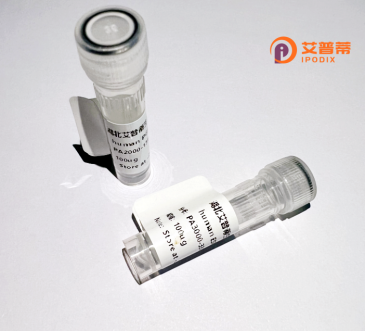
| 纯度 | >90%SDS-PAGE. |
| 种属 | Human |
| 靶点 | CDKL5 |
| Uniprot No | O76039 |
| 内毒素 | < 0.01EU/μg |
| 表达宿主 | E.coli |
| 表达区间 | 722-831aa |
| 氨基酸序列 | RPDNSFHENNVSTRVSSLPSESSSGTNHSKRQPAFDPWKSPENISHSEQLKEKEKQGFFRSMKKKKKKSQTVPNSDSPDLLTLQKSIHSASTPSSRPKEWRPEKISDLQT |
| 分子量 | 37.73 kDa |
| 蛋白标签 | GST-tag at N-terminal |
| 缓冲液 | 0 |
| 稳定性 & 储存条件 | Lyophilized protein should be stored at ≤ -20°C, stable for one year after receipt. Reconstituted protein solution can be stored at 2-8°C for 2-7 days. Aliquots of reconstituted samples are stable at ≤ -20°C for 3 months. |
| 复溶 | Always centrifuge tubes before opening.Do not mix by vortex or pipetting. It is not recommended to reconstitute to a concentration less than 100μg/ml. Dissolve the lyophilized protein in distilled water. Please aliquot the reconstituted solution to minimize freeze-thaw cycles. |
以下是关于重组人周期素依赖性激酶样5(CDKL5)蛋白的3-4篇参考文献及其简要摘要:
1. **文献名称**: *Mutations in CDKL5 cause severe neurodevelopmental disorders*
**作者**: Weaving, L.S., et al. (2004)
**摘要**: 首次报道CDKL5基因突变与婴儿痉挛症及严重神经发育障碍的关联,揭示其在早期大脑发育中的关键作用。
2. **文献名称**: *CDKL5 phosphorylates NGL-1 and regulates dendritic spine morphology*
**作者**: Ricciardi, S., et al. (2011)
**摘要**: 研究发现CDKL5通过磷酸化神经配体NGL-1调控树突棘形态,提出其在突触可塑性和神经功能中的分子机制。
3. **文献名称**: *The CDKL5 disorder is an independent clinical entity*
**作者**: Bahi-Buisson, N., et al. (2008)
**摘要**: 系统描述CDKL5缺乏症的临床特征(如早发性癫痫、严重运动及认知障碍),确立其为独立于Rett综合征的疾病类型。
4. **文献名称**: *Structural insights into the functional specificity of CDKL5*
**作者**: Mari, F., et al. (2016)
**摘要**: 通过解析CDKL5激酶结构域的晶体结构,阐明其独特的底物识别机制,并解释致病突变如何破坏激酶活性。
这些文献涵盖疾病关联、功能机制、临床分型和结构解析,为CDKL5研究提供了多维度视角。
CDKL5 (Cyclin-dependent kinase-like 5), also known as STK9. is a serine/threonine kinase encoded by the *CDKL5* gene located on the X chromosome (Xp22). Initially identified for its homology to mitotic kinases, CDKL5 is highly expressed in the brain, particularly in neurons, and plays a critical role in neurodevelopment and synaptic plasticity. It regulates dendritic morphogenesis, axon outgrowth, and neuronal connectivity, primarily through phosphorylation of targets like MeCP2. a protein linked to Rett syndrome.
Mutations in *CDKL5* cause CDKL5 deficiency disorder (CDD), a severe neurodevelopmental condition characterized by early-onset epilepsy, developmental delay, and autistic features. As an X-linked dominant disorder, it predominantly affects females, though males often exhibit more severe manifestations. Over 90% of CDD cases stem from *de novo* mutations, disrupting the kinase domain and impairing protein function.
Research focuses on elucidating CDKL5’s downstream pathways and developing targeted therapies, including gene therapy, enzyme replacement, and modulation of associated molecular networks (e.g., mTOR, BDNF). While no cure exists, advances in disease models and biomarker identification offer hope for future interventions. CDKL5’s interplay with neurodevelopmental pathways underscores its significance in brain function and disorder mechanisms.
×